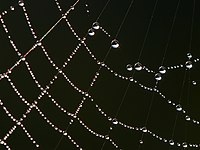
Photo from wikipedia
Inspired by the adhesion ability of various organisms in nature, the research of biomimetic adhesion has shown a promising application prospect in fields such as manipulators, climbing robots and wearable… Click to show full abstract
Inspired by the adhesion ability of various organisms in nature, the research of biomimetic adhesion has shown a promising application prospect in fields such as manipulators, climbing robots and wearable medical devices. In order to achieve effective adhesion between human skin and a variety of wearable sensors, two natural creatures, octopus and mussel, were selected for bio-imitation in this paper. Through imitating the octopus sucker structure, a micro-cavity array with a large inner cavity and small outer cavity was designed. The fabrication was completed by double-layer adhesive photolithography and PDMS molding, and the adhesion capacity of the structure was further enhanced by the coating of thermal responsive hydrogel PNIPAM. The adhesive force of 3.91 N/cm2 was obtained in the range of the human body temperature. PDA-Lap-PAM hydrogel was prepared by combining mussel foot protein (Mfps) with nano-clay (Lap) as biomimetic mussel mucus. It was found that 0.02 g PDA-Lap-PAM hydrogel can obtain about 2.216 N adhesion, with good hydrophilicity. Through oxygen plasma surface treatment and functional silane surface modification, the fusion of the PDMS film with biomimetic octopus sucker structure and the biomimetic mussel mucus hydrogel patch was realized. The biomimetic octopus sucker structure was attached to the human skin surface to solve the problem of shape-preserving attachment, and the biomimetic mussel mucus hydrogel was attached to the sensor surface to solve the problem of sensor surface adaptation. The fusion structure was used to attach a rigid substrate piezoelectric sensor to the skin for a human pulsewave test. The results verified the self-adhesion feasibility of wearable sensors with biomimetic structures.
Journal Title: Biosensors
Year Published: 2022
Link to full text (if available)
Share on Social Media: Sign Up to like & get
recommendations!